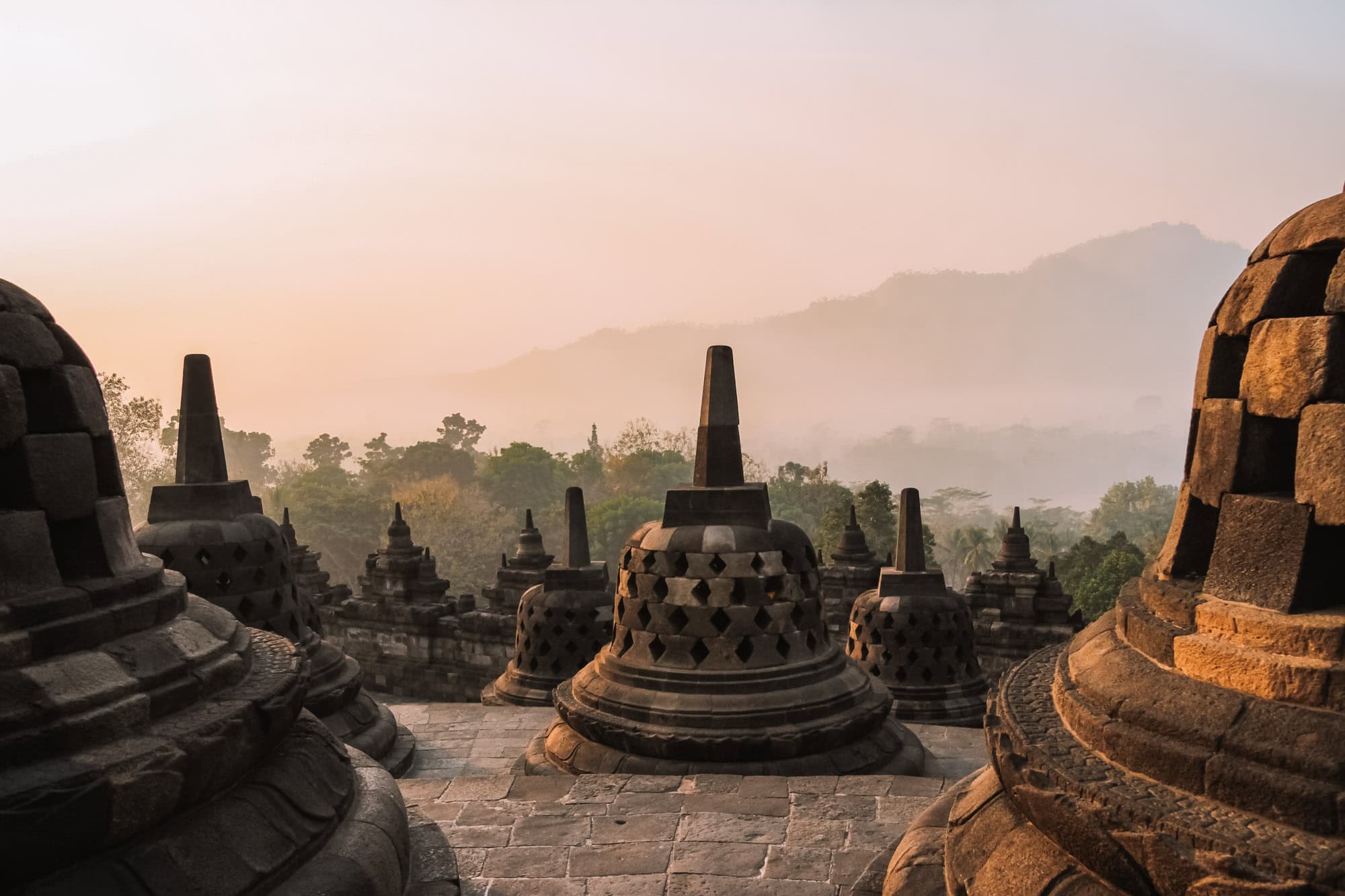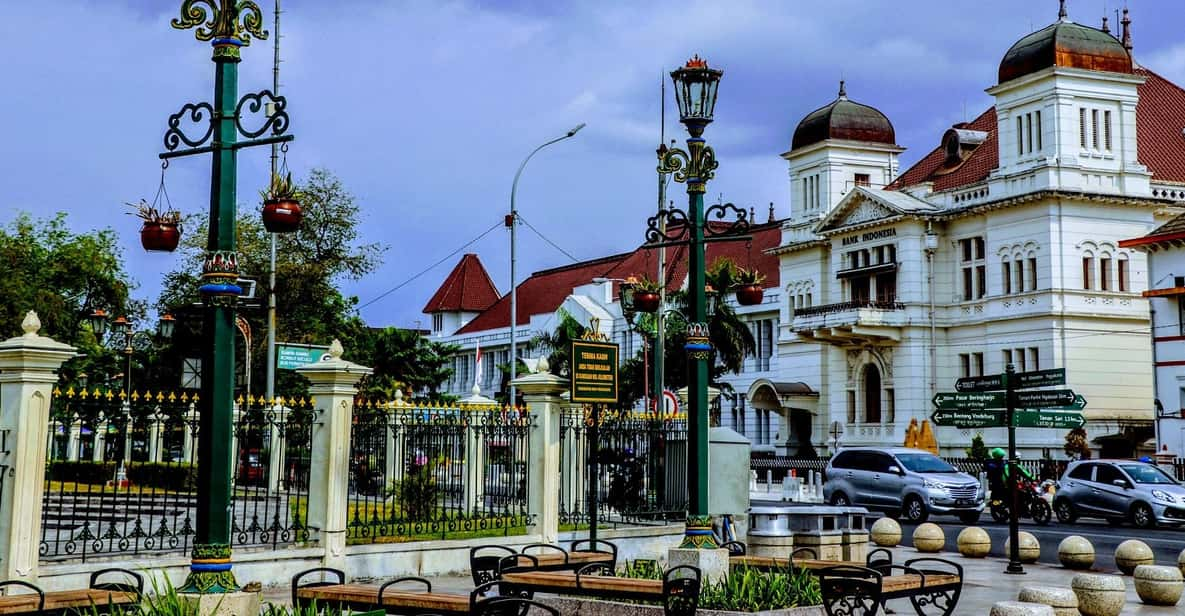Exploring the Thousand-Buddha Temple of Borobudur

Perched in Central Java, Indonesia, about 25 miles (40km) northwest of Jogjakarta’s center, Borobudur—the Thousand-Buddha Temple—rises like a giant Buddhist stupa amid a basin hugged by dense jungle. In 2012, the Guinness World Records crowned it the world’s largest Buddhist temple structure. Its name, Borobudur, comes from the Sanskrit “Vihara Buddha Ur,” meaning “Buddhist monastery on the hill.” From the hill’s base, you climb over 49 feet (15m) to reach the temple’s foundation.
Getting to Borobudur from Central Jogjakarta

I’ll walk you through the budget-friendly bus route to Borobudur. From central Jogjakarta, you’ll need two buses to get there. It’s just 25 miles (40km), but these local buses crawl, stopping tons, so it’s slow-going. The upside? You get to soak in the scenery along the way—everything in Indonesia’s got that simple, down-to-earth charm.
Remember the bus system I mentioned for Jogjakarta? Trans-Jogja—only 0.25 USD (3,500 Rp.) gets you all over the city. But hold up—if you’re in central Jogjakarta, lock this name in: Jombor Bus Terminal in northern Jogjakarta. Ask staff at any Trans-Jogja stop how to get there. I recall routes 2B and 2A can take you to Jombor Bus Terminal via the public system.
Jombor’s your first transfer hub—a local station up north. From there, ask for a bus straight to Borobudur. Tickets run 1-1.50 USD (15,000-20,000 Rp.), depending—watch out, they’ll hike prices for foreigners. I chatted up locals to pay what they did; can’t recall the exact fare now.
Key tip: When the bus from Jombor drops you at the final stop near Borobudur, dodge all the horse carts, motorbikes, taxis, and tuk-tuks hawking cheap rides. It’s just a 15-minute walk—super close, like 328 feet (100m), hehe.
Entering Borobudur with a Local Ticket
This was a total thrill—seriously! I’m not saying you should copy me, but if you try, you’re on your own if you get caught, okay?
Borobudur Entry Fees:
- 18 USD (250,000 Rp.) for foreigners, includes 1-2 free water bottles at a separate spot.
- 2 USD (30,000 Rp.) for Indonesians.
Do the math: a foreigner ticket’s about 20 USD (500,000 VND)—a big chunk for a backpacker. A local ticket? Just 2.50 USD (60,000 VND). That’s a 17.50 USD (440,000 VND) save! Plus, with my face—Thais say I look Thai, Indonesians say I look Indo—I felt bold enough to try.
Step 1: Ditch the two giant backpacks. No hotel, so where I go, they go. But rocking two huge bags screams “tourist”—no one’s buying I’m local. I tried stashing them at a nearby police station—no dice. Asked a friendly-looking local house near it—still no. Then, at a cafe over a drink, I asked to leave them, and bingo, success! Bag-free, I strutted toward the gate.
Step 2: Scout some Indonesian peers. Goal? Get them to buy my ticket. The ticket booth’s separate from the entrance, so I wandered, spotting two guys my age planning to hit Borobudur. Chatted them up, laid it out: “Tickets are pricey—can you grab mine too? We’ll stroll in together like it’s nothing.” Lucky me, they agreed to help.
Step 3: The big move—walking in with max confidence. Our trio had a plan: one guy upfront holds all three tickets, tells the guard, “We’re three,” then nods back at us. We flash smiles at the guard, grin at each other, and saunter through—no suspicious vibes. Boom, done! Saved a chunk of cash. You get a free sarong to wrap on—wear it even with long pants to show respect at this Buddhist site.
Best Time to Visit Borobudur?
Morning’s prime. They’ve got sunrise and sunset tours—pricey and tour-only, I think, since regular tickets expire at 4 p.m. You can’t stay inside the complex past then. Anyone snag a sunrise or sunset view from Borobudur? Let me know!
Exploring the Thousand-Buddha Temple of Borobudur
That’s the gist! Tons of Borobudur info’s online, but I’m sharing the practical stuff people skip—handy for your trip. I’ll sum up some key bits about Borobudur to spark your travel plans too.
Oh, cool fact: Every stone here’s volcanic, stacked with zero mortar—like Vietnam’s My Son Sanctuary in Quang Nam. They’re logically piled, solid as heck. Unlike My Son, where restored parts use mortar and sprout moss fast, Borobudur’s intact and massive—original stones moss-free.
Borobudur’s a jaw-dropping feat of Javanese craftsmanship. It’s perfectly symmetrical, with every Buddha statue and relief meaning something. Best way to explore? Circle each level from bottom to top—don’t miss a thing. Do it my way, and you’ll clock about 3 miles (5km) total.
The structure’s 9 stacked levels, each smaller than the last, soaring 138 feet (42m)—like a modern 10-story building. The bottom 6 levels are polygonal with 20 sides; the top 3 are circular—the design’s crown jewel, and where tourists snap the most pics. The first circle has 36 stupas (dome-like towers), the second 24—both dubbed Parinirwana, with diamond-shaped holes. The third circle’s got 16 Nirwana stupas with square holes, circling a massive central stupa.
The bottom 6 levels’ walls are plastered with intricate reliefs—life of the Buddha, bodhisattvas, enlightened heroes, and Buddhist teachings. They stretch over 2.5 miles (4km). Fully unpacking them? Two days minimum. Beyond reliefs, over 400 Buddha statues sit in the stupas and across Borobudur’s four faces. Archaeologists reckon this masterpiece took 100 years to build. After the Syailendra Buddhist dynasty fell, Borobudur was ditched and forgotten for 10 centuries. A European science crew, sent by Dutch colonial rulers, rediscovered it in 1814—half-ruined, buried under jungle. They think Mount Merapi’s 14th-century eruption hid it under ash, a lucky break that slowed time and human damage. Locals, under colonial orders, dug it out, and its grandeur floored everyone. By 1970, Indonesia tapped UNESCO for a full resto—600 top restorers spent 12 years and 50 million USD. Today, Borobudur’s nearly back to its prime, a world-famous wonder.
